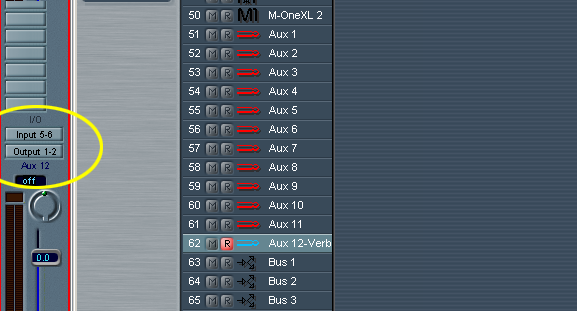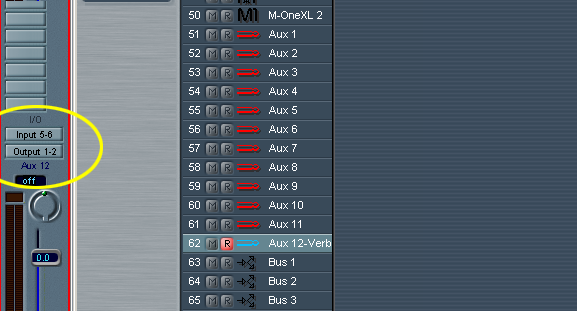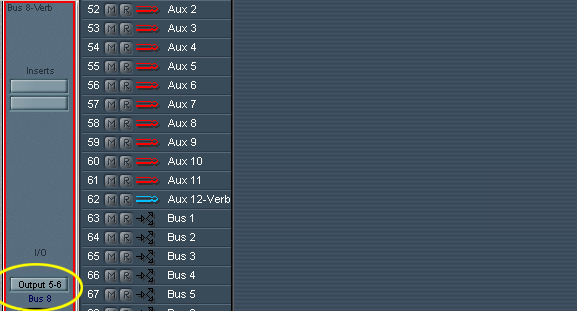I know many of you are on the new logic, I hope to get a mac in the near future. I would think the busing works the same still. My friend helped me set this up a few years ago so I just saved a template. I'm trying to understand the signal flow. I had a few questions, but it's kind of difficult to ask.
--
So right now I'm bringing in a M1 LX multi effects unit via an Auxiliary in logic. Inputs 5-6 in the aux channel are where it comes in from the outputs 5-6 of my audio interface. NOTE: I don't know why I have to specify an output (example 1-2) in the auxiliary if the bus is bring the wet signal into the channel I'm applying it to? Channels have their own outputs, so why do you need to specify an output for the aux? I have to or it won't work. That's my first question.
Regarding the bus: Logic's bus channels in v5.5 only have one place to select an input. In this case it's displayed as outputs. So this output section must be the audio interface's outputs that the bus grabs it's signal from (the wet signal). So when I increase the bus level on the audio channel, is it safe to say that logic is sending the dry channel signal to the auxiliary (which is where the effects unit is connected) then that wet signal comes back into logic and is mixed into the audio track?
I understand the concept of routing, but I don't understand where and to what the signals are being routed to without some kind of visual diagram.
Tags
Comments
Sorry if the question above was not articulated correctly. I gue
Sorry if the question above was not articulated correctly. I guess what I'm asking is. Why is the I/O section of the bus object labeled as outputs in order to bring my external effects unit in? Does this mean that the bus is getting it's input from the outputs? (My effects unit is coming into logic via 5-6 from the sound card). I have 4 books on logic and not one gets deep into bus routing. I need some kind of flow chart, anyone have one?
My books are all too generalized. Without understanding how the signal flow works you can't do much. I'm using the sends in the audio channels to send the signal to the bus. But the external effects unit is coming into though the AUX. This is confusing me. If the AUX has it's imput 5-6 which is what the effects unit is sending it's web signal to logic though, and output 1-2, What is the Bus actually doing?
I'm not a Logic guy (which also means I'm not a Mac guy, either,
I'm not a Logic guy (which also means I'm not a Mac guy, either, obviously)... so I can't answer your questions..
Have you tried searching for Youtube tutorials on the subject? Very often, there is quite a bit of information available from other users who have cracked the code on many issues and questions that te manuals don't always cover, and who will often share what they've found...
Hello DonnyThompson. Like I mentioned, I've got it working as I
Hello DonnyThompson.
Like I mentioned, I've got it working as I saved an auto load template my friend helped me with a few years ago. And I just found the manual. Here is what's confusing, and this is how I have it setup.
- My effects unit comes in via the audio card's hardware 5-6.
- In logic I have an Aux channel strip with Input 5-6 / Output 1-2
- I have a bus set up with it's I/O set to Outputs 5-6
The logic Audio manual says:
Bus Objects
They can be used to route audio signals to external devices
via the individual outputs of the audio hardware, allowing
you to change their level and pan settings, and apply plug-
ins, if you like.
Here is what's confusing about the output statement: If you're sending the dry signal from the audio track to a bus using the bus send knob, and the bus channel that is assigned to that knob is pulling the effect into logic from the external unit, then shouldn't that output be labeled as an input into the bus, which is then mixed and sent out 1-2? But that's not how it works. It's the "AUX channel that connects the effects unit" and also has the outputs 1-2 set there. Not in the bus. So what I'm trying to understand is: Can a bus actually send a signal though hardware outputs (as it seems is the case here) and then pull the processed signal back into logic though those same outputs to be mixed into the signal?
NOTE: As mentioned, I have all this working fine, but I don't understand how the routing is being done under the hood in logic. The logic manual has a very basic flow chart of how a send works, which I already know. But it doesn't get deep into how the In/out works with regard to the direction the paths flow to and from external equipment.
I really wish I could help you - but as I mentioned, I'm not a
I really wish I could help you - but as I mentioned, I'm not a Logic guy - so as far as how Logic handles its internal routing, I would think that you would be more knowledgeable than I on this; my time on Logic is limited to mixing in it for a few hours at client's homes studios, and that doesn't equate to nearly enough time to speak with any type of authority (nor even with a novice-level of confidence) on the platform.
The reason I posted the links wasn't to direct you to a video that I knew had the answers you were seeking....I posted the links because I thought that perhaps they might have been of some help to you, and could maybe address your questions.
You should probably contact Logic Tech Support at this point, I'm sure they'll be your best bet, and would be able to answer your question(s), after all, it's their program.
I can empathize with how much of a PITA various manufacturers Tech Support lines can be, but sometimes, we just have to bite the bullet and do it, if we can't find the answers to our questions through other means.
Sorry I couldn't assist you further... so, unless someone else here on RO can weigh in on this, I think your best bet is to contact Logic Support. ;)
-d.
Hello Donny I think I got what's going on after reading this pa
Hello Donny
I think I got what's going on after reading this page in the section titled: The Signal Flow of Sends.
http://www.askaudiomag.com/articles/signal-flow-in-logic-101
Basically, unlike the new versions of logic which have sends in the buses themselves, Logic 5.5 hides it's output to the external effect unit (The output that the channel send is sending to). It hides it's output in the AUX channel. In other words, it works in the following order:
Bringing in an effects from an external unit.
- You create a bus channel in logic so that a send appears in the audio channel strip.
- You also created an Auxiliary, the Aux is what contains the hidden virtual output to the effects unit (you don't see this output in the drop down options) and also contains the input that the wet signals returns through - back into Logic. These inputs are the outputs of your effects unit.
- When you turn the send up on the audio channel, the bus sends the signal to the Aux channel
- Then the Aux channel sends the dry signal to the external effects unit.
- Then the wet signal returns back into the logic via the Aux's input and is sent to the master outputs to be mixed with the original signal/stereo outs.
- The reason the bus can send the dry signal to the effects unit, is because the bus's I/O drop down points to the outputs 5-6 which actually comes into logic though the Aux.
It's very confusing. I don't know how my friend figured this out, because all the manuals I've read suck at explaining these things. But it works.
Similar by terms
- Big-band blues with a hint of metal
- Apogee 800 toslink into motu optical, low input level on logic
- Why no audio being played through MOTU 8pre USB even though the meters on Logic and iTunes are blazing.
- Brand new KRK Rokits crackling in playback, Logic Pro X
- Logic Pro X monitoring not working but only with new inputs?









Sorry if the original question above was not articulated correct
Sorry if the original question above was not articulated correctly.
I guess what I'm asking is. Why is the I/O section of the bus object labeled as outputs in order to bring my external effects unit in? Does this mean that the bus is getting it's input from the hardware outputs of the effects unit, or are these pointing to the outputs I have specified in my AUX channel? I have 4 books on logic and not one gets deep into bus routing. (My effects unit is coming into logic via 5-6 from the sound card). I have 4 books on logic and not one gets deep into bus routing. I need some kind of flow chart, anyone have one?
My books are all too generalized. Without understanding how the signal flow works you can't do much. I'm using the sends in the audio channels to send the signal to the bus. But the external effects unit is coming into though the AUX. This is confusing me. If the AUX has it's input as 5-6 (which are the hardware inputs I'm assuming) and this same AUX is sending the wet signal out though outputs 1-2, What is the Bus actually doing with its section labeled as outputs? Are these the outputs from the AUX channel object, or the hardware outputs?